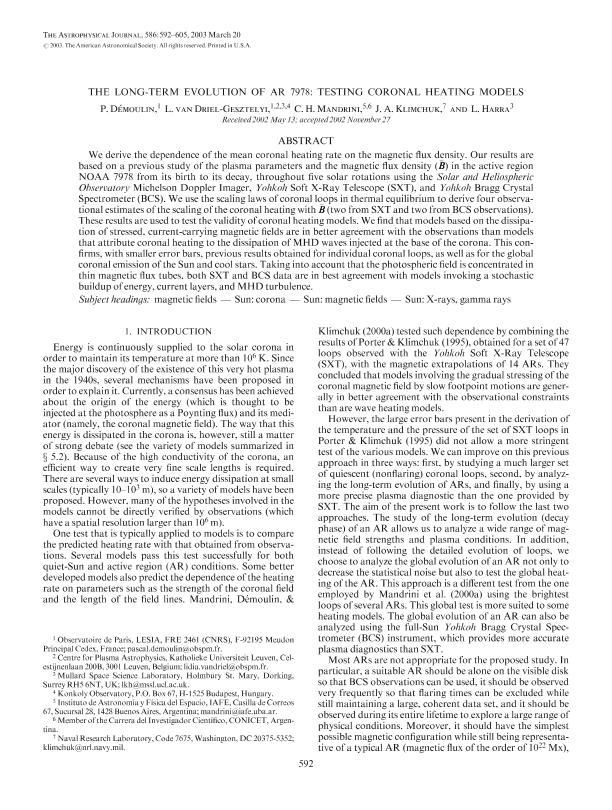Mostrar el registro sencillo del ítem
dc.contributor.author
Démoulin, Pascal

dc.contributor.author
van Driel Gesztelyi, Lidia

dc.contributor.author
Mandrini, Cristina Hemilse

dc.contributor.author
Klimchuk, J. A.
dc.contributor.author
Harra, L. K.
dc.date.available
2017-07-24T18:26:31Z
dc.date.issued
2003-12
dc.identifier.citation
Démoulin, Pascal; van Driel Gesztelyi, Lidia; Mandrini, Cristina Hemilse; Klimchuk, J. A.; Harra, L. K.; The long-term evolution of AR 7978: Testing coronal heating models; IOP Publishing; Astrophysical Journal; 586; 1; 12-2003; 592-605
dc.identifier.issn
0004-637X
dc.identifier.uri
http://hdl.handle.net/11336/21177
dc.description.abstract
We derive the dependence of the mean coronal heating rate on the magnetic flux density. Our results are based on a previous study of the plasma parameters and the magnetic flux density (B) in the active region NOAA 7978 from its birth to its decay, throughout five solar rotations using the Solar and Heliospheric Observatory Michelson Doppler Imager, Yohkoh Soft X-Ray Telescope (SXT), and Yohkoh Bragg Crystal Spectrometer (BCS). We use the scaling laws of coronal loops in thermal equilibrium to derive four observational estimates of the scaling of the coronal heating with B (two from SXT and two from BCS observations). These results are used to test the validity of coronal heating models. We find that models based on the dissipation of stressed, current-carrying magnetic fields are in better agreement with the observations than models that attribute coronal heating to the dissipation of MHD waves injected at the base of the corona. This confirms, with smaller error bars, previous results obtained for individual coronal loops, as well as for the global coronal emission of the Sun and cool stars. Taking into account that the photospheric field is concentrated in thin magnetic flux tubes, both SXT and BCS data are in best agreement with models invoking a stochastic buildup of energy, current layers, and MHD turbulence.
dc.format
application/pdf
dc.language.iso
eng
dc.publisher
IOP Publishing

dc.rights
info:eu-repo/semantics/openAccess
dc.rights.uri
https://creativecommons.org/licenses/by-nc-sa/2.5/ar/
dc.subject.classification
Astronomía

dc.subject.classification
Ciencias Físicas

dc.subject.classification
CIENCIAS NATURALES Y EXACTAS

dc.title
The long-term evolution of AR 7978: Testing coronal heating models
dc.type
info:eu-repo/semantics/article
dc.type
info:ar-repo/semantics/artículo
dc.type
info:eu-repo/semantics/publishedVersion
dc.date.updated
2017-07-24T14:12:37Z
dc.journal.volume
586
dc.journal.number
1
dc.journal.pagination
592-605
dc.journal.pais
Reino Unido

dc.journal.ciudad
Londres
dc.description.fil
Fil: Démoulin, Pascal. Centre National de la Recherche Scientifique. Observatoire de Paris; Francia
dc.description.fil
Fil: van Driel Gesztelyi, Lidia. Centre National de la Recherche Scientifique. Observatoire de Paris; Francia
dc.description.fil
Fil: Mandrini, Cristina Hemilse. Consejo Nacional de Investigaciónes Científicas y Técnicas. Oficina de Coordinación Administrativa Ciudad Universitaria. Instituto de Astronomía y Física del Espacio. - Universidad de Buenos Aires. Facultad de Ciencias Exactas y Naturales. Instituto de Astronomía y Física del Espacio; Argentina
dc.description.fil
Fil: Klimchuk, J. A.. Spece Sciences División. Naval Research Laboratory; Estados Unidos
dc.description.fil
Fil: Harra, L. K.. Mullard Space Science Laboratory; Reino Unido
dc.journal.title
Astrophysical Journal

dc.relation.alternativeid
info:eu-repo/semantics/altIdentifier/url/http://iopscience.iop.org/article/10.1086/367634
dc.relation.alternativeid
info:eu-repo/semantics/altIdentifier/doi/http://dx.doi.org/10.1086/367634
Archivos asociados
